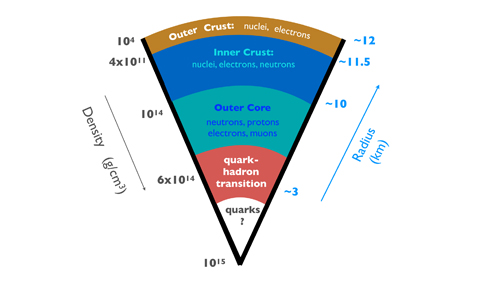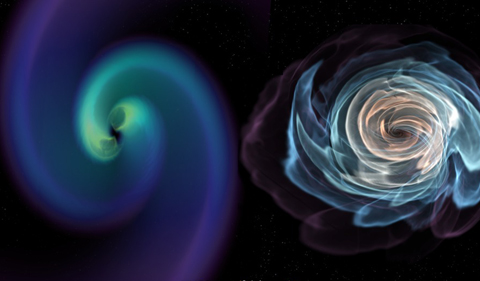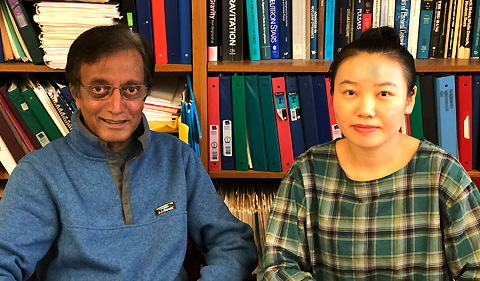What form of matter resides in the cores of neutron stars?
A team of astrophysicists from Ohio University and Kent State University has published the latest in a series of articles about neutron star interiors, “Treating quarks within neutron stars,” in Physical Review D, a journal of the American Physical Society.
Dr. Madappa Prakash, Professor in Physics & Astronomy and post-doctoral researcher Sophia Han joined efforts with OHIO alumni Md. Abdullah Al Mamun, Sudhanva Lalit and former OHIO postdoctoral researcher Constantinos Constantinou, a researcher at Kent State University. Han is concurrently a postdoctoral fellow at the University of California at Berkeley.
“We examined various scenarios of how quarks may emerge and interact,” Prakash said. “We studied manifestations of their presence through calculations of the sound velocity (a proxy for the relationship between pressure and density in matter containing quarks), mass-radius relations of cold stable neutron stars, and tidal effects in binary neutron star mergers.”
The central densities of known neutron stars whose masses range from one to two times that of the sun far exceed those of terrestrial atomic nuclei. At such extreme densities, the expectation is that, quarks, the constituents of protons and neutrons (collectively called as hadrons) that make up nuclei may be liberated. The transition from matter containing only hadrons to that containing quarks is known as the hadron-to-quark phase transition.

A pie chart of the internal structure and composition of a neutron star. Possible phase transitions to states of matter containing nuclei, nucleons, and other exotic states such as hyperons, meson condensates, and quarks as the density increases toward the core are as shown. The corresponding distances are as indicated on the right.
Although quantum chromodynamics, the theory of strong interactions between particles such as hadrons and quarks, is well established, calculations for the conditions of low temperature and high density in neutron stars have been thwarted owing to technical difficulties. Thus, the precise nature of the hadron-to-quark phase transition currently remains beyond the reach of researchers.
Prospects of observationally exploring the presence of quark matter in neutron star cores have increased with the recent detection in August 2017, of gravitational waves from the merger of two neutron stars, an event known as GW170817. The simultaneous detection of electromagnetic waves from this event has ushered in the era of multi-messenger astronomy as a probe of ultra-dense matter.
In the interior of massive neutron stars, the repulsive pressure of matter has to be sufficiently high to counter the enormous attractive pull of gravitational forces. This implies that the strength of interactions between quarks, were they to exist, is also very high.
“From the extensive analyses performed, the findings of our work have narrowed down the options for the nature of the hadron-to-quark phase transition to be compatible with available observational data,” Han noted. “In addition, we have identified the required conditions to confirm the presence of quarks through the detection of gravitational and electromagnetic signals from binary merger events.”
Studying Neutron Star Composition at Extreme Densities
Han further explores the composition of neutron stars at extreme densities in a recently submitted paper, “Studying strong phase transitions in neutron stars with gravitational waves.” She and colleague Katerina Chatziioannou of the Center for Computational Astrophysics at the Flatiron Institute examine how well future observations of merger events with improved detector capabilities can constrain the properties of the phase transition, primarily its onset density and strength.

First Cosmic Event Observed in Gravitational Waves and Light. This imagery shows the coalescence of two orbiting neutron stars. The right panel contains a visualization of the matter of the neutron stars. The left panel shows how space-time is distorted near the collisions. Credit: LIGO Caltech Karan Jani/George Tech
Han and Chatziioannou are excited at the prospect of observing hundreds of binary mergers with upgraded detectors in the near future. “Currently, effects from non-hadronic degrees of freedom have not been considered in analyzing the data from GW170817,” said Han. “These exotic phases of matter can significantly alter the conclusions reached about the physical properties of the merging neutron stars. We have shown that a comprehensive framework with a proper treatment of phase transitions is imperative to learn about what resides within neutron stars.”




















Comments